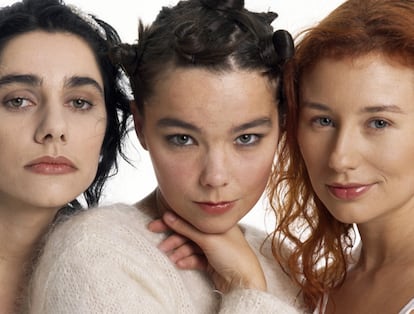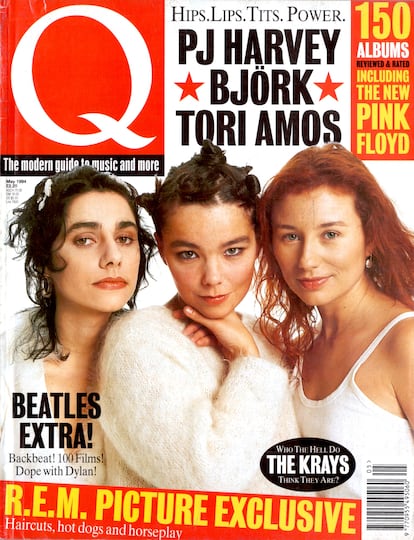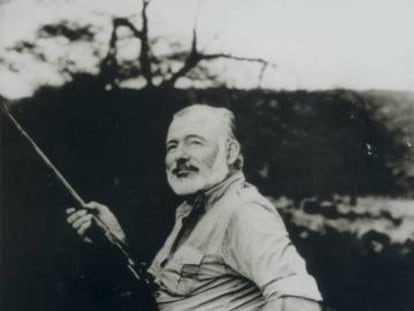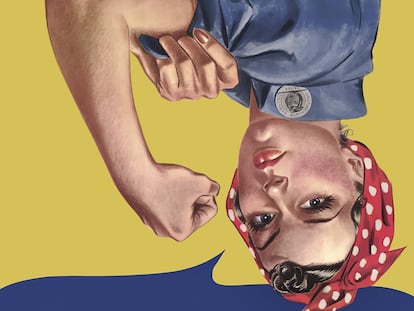‘Hips, Lips, Tits, Power’: The controversial misogynistic cover that angered Tori Amos, PJ Harvey and Björk
The journalist Toni Castarnado analyzes the impact of ‘Q’ Magazine on a generation of women artists

On May 29, 1994, seven weeks after Kurt Cobain died by suicide, the British music magazine Q brought together the American artist Tori Amos, England’s PJ Harvey and Iceland’s Björk, beneath the title “Hips, Lips, Tits, Power.” The women had released five albums between the three of them, and the only thing that they shared was the uniqueness of their far-from-commercial musical styles. But what none of them would imagine is that, with the passage of time, the encounter would become historic: not just because of the cover, shot by photographer John Stoddart, but for the anger it passed down to future generations of artists. After years marked by the testosterone of grunge, a new batch of women was claiming their spot in the industry.
In the early 1990s, the third wave of feminism and the alternative scene gave rise to movements like the Riot Girls, with Bikini Kill, Bratmobile and Heavens to Betsy. But as sexist as it seems now, at that time, women needed to do something different in order for the media and the general male public to take them seriously. The protagonists of this story managed to do so.

“Their groundbreaking discourse, as well as their desire to be heard by the masses, brought a paradigm shift,” says Toni Castarnado, author of the book Las Chicas del Q [The Q Girls], published by Sílex Ediciones. “Björk innovated with her mix of pop and electronica, since before [the album] Debut nothing similar had been heard. PJ Harvey, above all in her first albums, stood out because of the electricity, sensuality and viscerality of her lyrics. And Tori Amos, despite her more classic appearance, was tremendously daring: on her first album, Little Earthquakes, she opened up, as on songs like Me and a Gun, where she narrated how she survived a rape at 21 years old. Without them, future stars like Sheryl Crow and Alanis Morissette would not have enjoyed too much attention and recognition.”
Castarnado recalls that the Q cover was not immediately considered ironic. “It started to be seen that way years later, when the three consolidated their careers and became untouchable,” he says. “But for me, personally, I was always curious what was behind it, how it came together, why the magazine chose them and not others.” Though three decades have passed, there are still more questions than answers.
It is a known fact that the women attended a shoot on February 24, 1994, in a photo studio in the London neighborhood of Islington. Any other available information is thanks to the photographer Stoddart. In 2006, during the presentation of the exhibition Q Idols at the British capital’s Getty Images Gallery, he said, “Björk, PJ Harvey and Tori Amos represented a new wave of female rock. They didn’t know each other beforehand. I thought it would be a real headache to have these three egos in the studio, but they couldn’t have been friendlier to each other. There was no prima donna behavior, and they all exchanged numbers afterwards. The only thing I regret is that Björk had the worst hairstyle of her career at that time.”
Hairdos aside, Castarnado writes that the portrait’s timelessness lies in its simplicity: “Stoddart reflected their distinctive attitudes, power and features without artifice. PJ Harvey faces the camera cold and distant, Björk looks more eccentric and Tori poses looking relaxed and trusting. The closeness, as well as the communion among the three of them, is what made the image transcend.” The session had the same effect as Peter Lindbergh’s shoot for British Vogue in January 1990, which catapulted Cindy Crawford, Naomi Campbell, Tatjana Patitz, Christy Burlington and Linda Evangelista to supermodel status.
The interviews in the magazine were conducted by Adrian Deevoy. The journalist provokes them, asking if they have ever felt in competition with the two others. They respond with a resounding no. Tori Amos, in particular, adds, “It’s funny for women because journalists pit women against each other. If you think about Jimi Hendrix, Jimmy Page and Eric Clapton, they were all much more similar to each other than we are. We have tits. We have three holes. That’s what we have in common. We don’t even play the same instruments. It really disappoints me when some sort of competition has to be manufactured for their little minds and fantasies. That’s not growing, that’s not support. There is room for everybody on the planet to be creative and conscious if you are your own person. If you’re trying to be like somebody else, then there isn’t. We see things from different points of view and that affects people in different ways and I think that should be encouraged. It shouldn’t be like, two tits too many. Like with radio in America, they tell you, ‘Well, we’re already playing one female this week.’ They wouldn’t think about that with guys.”
Another memorable point, which reflects the discrimination the women faced, occurred when Deevoy asked whether they had been heckled at concerts. All three had: “Get off the stage, you fucking whore! They shout that and so you go, ‘Look, I’m here for an hour and fucking 20 minutes and if you don’t have a gun to blow me off the stage then I’m staying.’ When that happens, your first reaction is to just crawl into a bubble bath and have a pizza. But you have to respect yourself and draw the line and deal with it. I don’t like confrontations, but you have to do something,” Tori said. PJ Harvey answered: “I’ve had people from beginning to end just shouting, ‘You fucking bitch! Go back to fucking Yeovil!’ I always wonder why they’ve paid money to do that. I just smile and sing at them, and that seems to work. Dedicate a song to them, maybe. That always works.” Björk, in addition to remembering that she was once called “Meat Loaf,” added: “You learn, after a while, to turn everything into something that turns you on. It’s like you’ve got this button. You learn to use things. If someone shouts at you, you can use it to make a song better.”
Paradoxically, despite the harmony between the three women, the encounter did not lead to any significant collaborations. The only one occurred days before the photo shoot and interview, February 14, 1994, at the fourteenth edition of the Brit Awards: despite the organizers planning for Björk to sing with Meat Loaf and PJ Harvey with Jamiroquai, both of them ended up covering (I Can’t Get No) Satisfaction by The Rolling Stones. “Writing the essay, I discovered that Tori Amos, in some of her concerts, played Björk’s Hyperballad,” Castarnado recalls. “But the fact that the three did not become close friends, or do anything else together, makes the cover even more important. It captured a moment in Islington that would never occur again.”
Sign up for our weekly newsletter to get more English-language news coverage from EL PAÍS USA Edition
Tu suscripción se está usando en otro dispositivo
¿Quieres añadir otro usuario a tu suscripción?
Si continúas leyendo en este dispositivo, no se podrá leer en el otro.
FlechaTu suscripción se está usando en otro dispositivo y solo puedes acceder a EL PAÍS desde un dispositivo a la vez.
Si quieres compartir tu cuenta, cambia tu suscripción a la modalidad Premium, así podrás añadir otro usuario. Cada uno accederá con su propia cuenta de email, lo que os permitirá personalizar vuestra experiencia en EL PAÍS.
¿Tienes una suscripción de empresa? Accede aquí para contratar más cuentas.
En el caso de no saber quién está usando tu cuenta, te recomendamos cambiar tu contraseña aquí.
Si decides continuar compartiendo tu cuenta, este mensaje se mostrará en tu dispositivo y en el de la otra persona que está usando tu cuenta de forma indefinida, afectando a tu experiencia de lectura. Puedes consultar aquí los términos y condiciones de la suscripción digital.
More information
Archived In
Últimas noticias
Most viewed
- Sinaloa Cartel war is taking its toll on Los Chapitos
- Oona Chaplin: ‘I told James Cameron that I was living in a treehouse and starting a permaculture project with a friend’
- Reinhard Genzel, Nobel laureate in physics: ‘One-minute videos will never give you the truth’
- Why the price of coffee has skyrocketed: from Brazilian plantations to specialty coffee houses
- Silver prices are going crazy: This is what’s fueling the rally











































